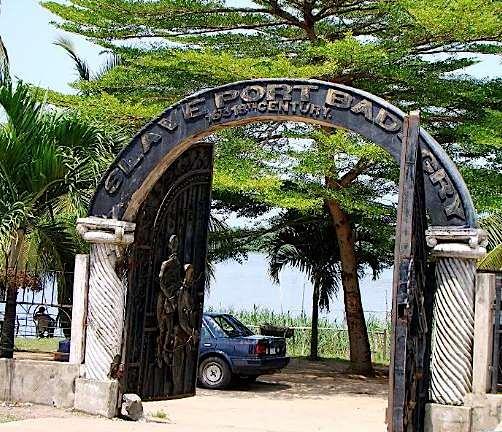I recently went on a tour to Badagry, a coastal town in Lagos, Nigeria, organized by Travel Next Door to celebrate Nigeria’s Democracy Day. Badagry was unfortunately used as a slave port from the 15th to 19th centuries, where captives were transported to Bahia, Brazil. The experience drove home the graveness of the captives’ situation as they were forced against their will to never see their homeland again.
SEE ALSO: Cameroon Celebrates 8th Physical Education Day
On the road to Badagry, the enthusiasm on the tour bus lifted and everyone peered out of the windows, trying to soak it all in once we saw the placard that confirmed we had arrived. We passed the Sator drums at the roundabout. The Sator drum is beaten during important festivals and usually only by orphans.
Then we made our way to the Badagry Heritage Museum. One of the tour guides took us through each room, and we were shown a book that contained much of Nigeria’s history as well as notable stories about Badagry. On entering the museum, one sees a statute of a man with his hands in the air and chains around his feet. He looks happy as if he is saying, “Freedom at last.”
We moved to other rooms that house slave chains: There are chains for stubborn people, chains for women, and metal coverings to put around someone’s mouth to prevent them from talking. A couple of pictures showed us the’Awon Iya Wa‘(our mothers), priestess of Odua.
Another gallery has specially designed ships used to transport human cargo along with other materials. Then we were taken to see our first glimpse of the Lagoon, where foreign ships would wait while trade boats went ashore to pick up humans for sale.
It was a touching and humbling experience that got me angry.
Another gallery had pictures, notes, and deeds of the abolitionists who fought for the end of slavery. I was touched by the picture of’John Brown (pictured at left) who — while being bound and having been sentenced — kissed a “n*gger” baby.
Our tour finally came to an end as we moved to the spot Christianity was first preached in Nigeria: An Agia tree used to be at the spot, but it has since been torn down and replaced with a monument. Many Christians come to this spot as a form of pilgrimage, because Badagry is where it all started.
Next we visited the Seriki Abass barracoon, which is a cage/cell for captured men, women, and children. They were kept here to await trading boats who come looking for human cargo. As many as 40 people were confined in to one room.
The smell and cramped space was a way to filter the weak from the strong, and at the end, about only 20 percent survived and the price on these “fit,” able ones usually increased.
No loss to the slave dealer.
 Directly opposite the barracoon was the boat dock to the Island of No Return (pictured at right). We got in to life jackets and headed to the island.
Directly opposite the barracoon was the boat dock to the Island of No Return (pictured at right). We got in to life jackets and headed to the island.
Watching the shoreline disappear, knowing you will never see your beloved homeland again must have been painful. At the museum, there was a picture of a clan chief who stabbed himself rather than be captured and turned into a slave.
As the island loomed nearer, one could not help but notice that the island is beautiful. Notwithstanding the history of the place, visually, it was a perfect paradise: The trees stand high, proud, and strong, and the sand was clean, white, and warm.
We then started our 2.5KM walk to the end of the island. On our walk, we passed the well, where the captured were forced to drink from.
Legend has it that the water was bewitched, because after drinking the water, you lost all memories of home, became docile, and followed orders. Some claim the water was drugged, but stories indicate that as soon as the captives set foot in the foreign land, they regained their senses. This must have been how a crew of 10 to 15 slave dealers could have kept control over as many as 700 slaves.
Other stories told of revolts that happened at sea where the captives captured and overthrew the captors. We were happy to hear about this.
At the beach front, we met two pillars that are said to be the points that marked the end. After going through those pillars, there was no turning back, because runaways were shot immediately or had wild dogs sent after them.
Afterward, we made our way to the Perma Culture garden, had a nice treat of coconut water (pictured), and a jogun, which is a local biscuit made in Badagry. All too quickly we started to make our way back to Lagos. The journey back was a reflective one, where we all thought about what we had seen and were silently grateful for Freedom.
SEE ALSO: Ghanaian Designers Bring Freshness To 3rd Edition of White Carpet Fashion Show













